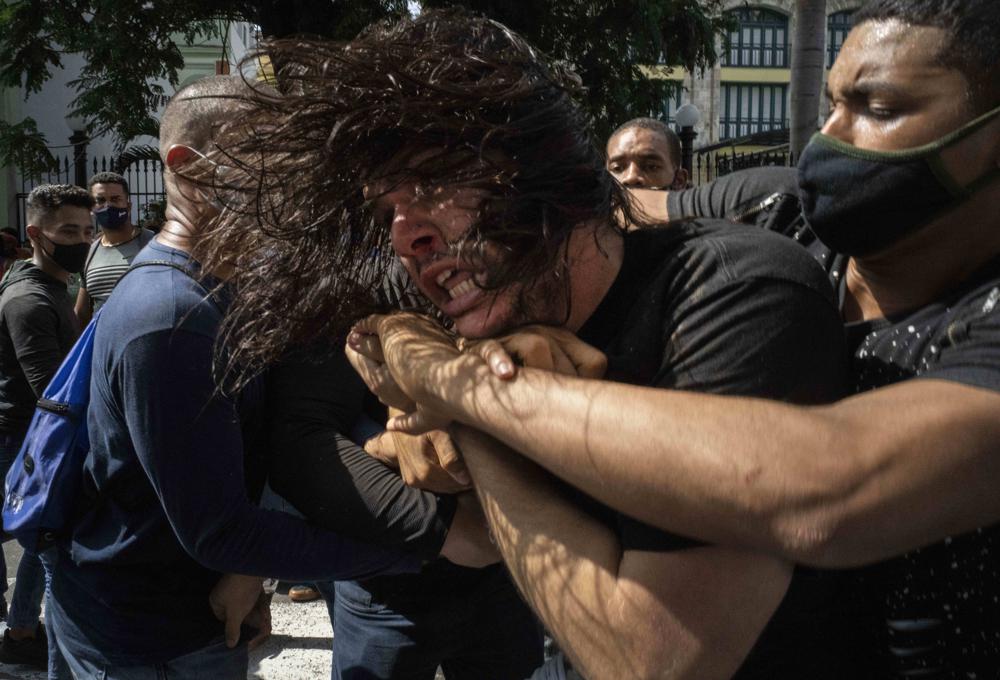
Large contingents of Cuban police patrolled the capital of Havana on Monday following rare protests around the island nation against food shortages and high prices amid the coronavirus crisis. Cuba’s President said the demonstrations were stirred up on social media by Cuban-Americans in the United States.
Many young people took part in the Sunday protests in Havana, which disrupted traffic until police moved in after several hours and broke up the march when a few protesters threw rocks.
Cuba is going through its worst economic crisis in decades, along with a resurgence of coronavirus cases, as it suffers the consequences of U.S. sanctions imposed by former President Donald Trump’s administration.
The demonstrations in Havana and other communities around the tightly controlled country marked some of the biggest displays of antigovernment sentiment in decades, and authorities appeared determined to put a stop to them. Internet service was also spotty, possibly indicating an effort to prevent protesters from communicating with each other.
“We’ve seen how the campaign against Cuba was growing on social media in the past few weeks,″ President Miguel Díaz-Canel said Monday in a nationally televised appearance in which his entire Cabinet was also present. “That’s the way it’s done: Try to create inconformity, dissatisfaction by manipulating emotions and feelings.”
In a statement Monday, U.S. President Joe Biden said Cuban protesters were asserting their basic rights.
’’We stand with the Cuban people and their clarion call for freedom and relief from the tragic grip of the pandemic and from the decades of repression and economic suffering to which they have been subjected by Cuba’s authoritarian regime,″ Biden said.
The U.S. urges the Cuban government to serve their people ’’rather than enriching themselves,″ Biden added.
U.N. deputy spokesman Farhan Haq on Monday stressed the U.N. position “on the need for freedom of expression and peaceful assembly to be respected fully, and we expect that that will be the case.”
The demonstrations were extremely unusual on an island where little dissent against the government is tolerated. The last major public demonstration of discontent, over economic hardship, took place nearly 30 years in 1994. Last year, there were small demonstrations by artists and other groups, but nothing as big or widespread as what erupted this past weekend.
In the Havana protest on Sunday, police initially trailed behind as protesters chanted, “Freedom!” “Enough!” and “Unite!” One motorcyclist pulled out a U.S. flag, but it was snatched from him by others.
“We are fed up with the queues, the shortages. That’s why I’m here,” one middle-age protester told The Associated Press. He declined to identify himself for fear of being arrested later.
Later, about 300 pro-government protesters arrived with a large Cuban flag, shouting slogans in favor of the late President Fidel Castro and the Cuban revolution. Some assaulted an AP videojournalist, smashing his camera. AP photojournalist Ramón Espinosa was then beaten by a group of police officers in uniforms and civilian clothes; he suffered a broken nose and an eye injury.
The demonstration grew to a few thousand in the vicinity of Galeano Avenue and the marchers pressed on despite a few charges by police officers and tear gas barrages. People standing on many balconies along the central artery in the Centro Habana neighborhood applauded the protesters passing by. Others joined in the march.
Although many people tried to take out their cellphones and broadcast the protest live, Cuban authorities shut down internet service throughout the afternoon.
About 2 1/2 hours into the march, some protesters pulled up cobblestones and threw them at police, at which point officers began arresting people and the marchers dispersed.
AP journalists counted at least 20 people who were taken away in police cars or by individuals in civilian clothes.
Demonstrations were also held elsewhere on the island, including in the small town of San Antonio de los Baños, where people protested power outages and were visited by Díaz-Canel. He entered a few homes, where he took questions from residents.
___
Republished with permission of The Associated Press.



